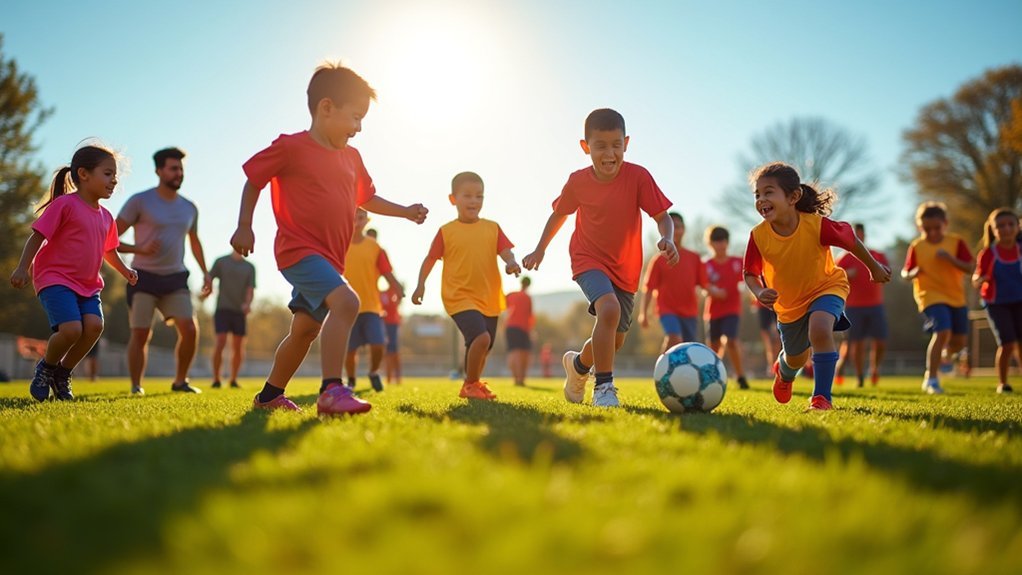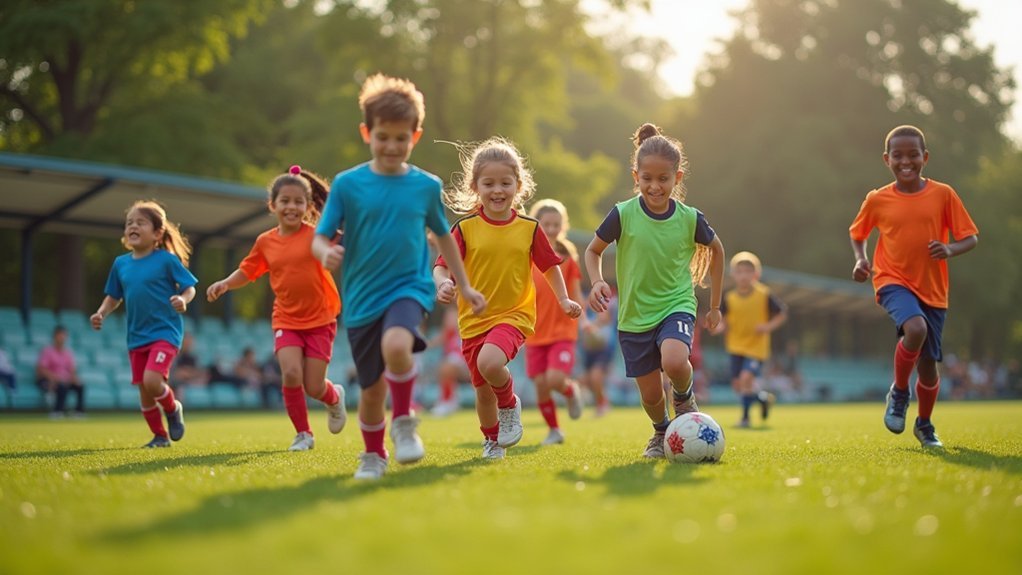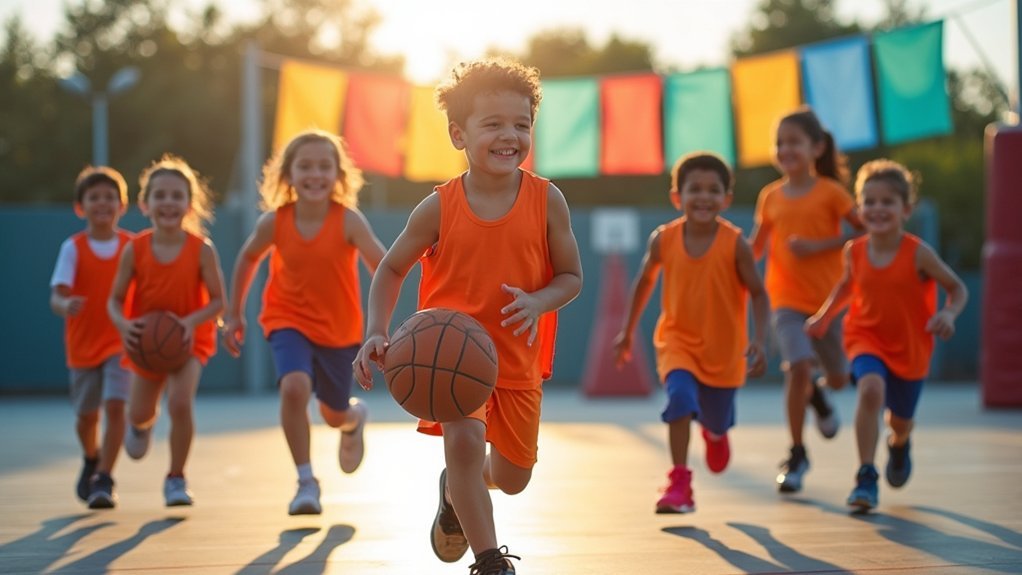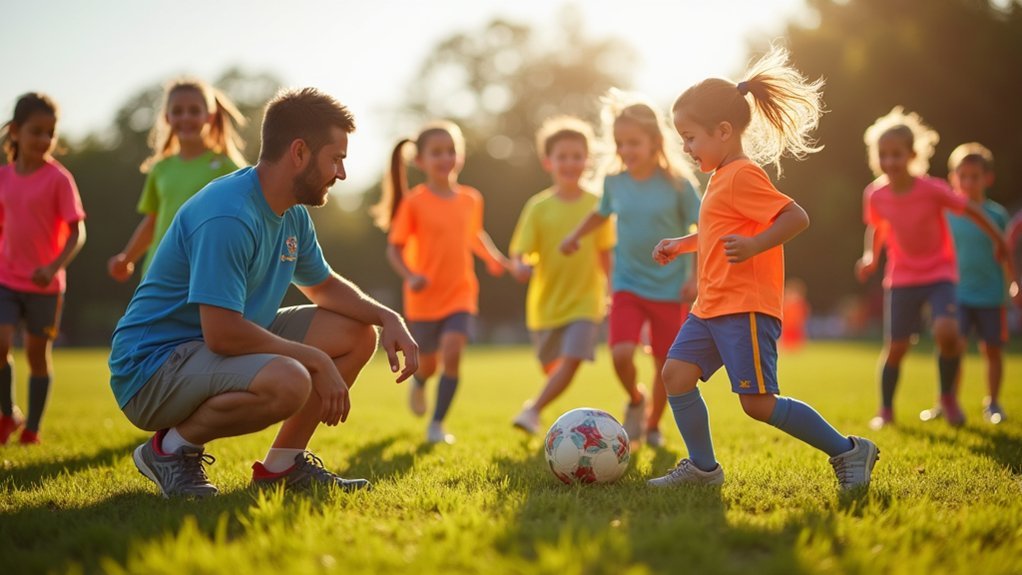Team sports offer autistic children structured environments that build social skills through predictable routines and clear rules. You’ll find options like adaptive basketball, modified soccer, and team swimming programs that accommodate sensory needs through noise control, visual aids, and consistent coaching. When choosing a sport, consider your child’s interests, sensory preferences, and motor abilities. The right team setting creates powerful social bridges while celebrating neurodiversity—just the beginning of their journey toward confidence and connection.
12 Second-Level Headings for “Team Sports Designed for Autism Success”

Everyone can benefit from structured physical activity that fosters connection. For individuals with autism spectrum disorder, specially designed team sports offer unique opportunities to develop essential social skills while improving physical fitness.
Programs like Special Olympics create environments where participants can engage with peers in structured settings that accommodate their specific needs. The unified approach integrates athletes with and without disabilities, building teamwork abilities through shared experiences.
You’ll find these programs particularly valuable as they address multiple development areas simultaneously: communication skills improve as players learn to coordinate with teammates, sedentary behaviors decrease through regular activity, and meaningful friendships form through shared achievements.
The structured nature of team sports provides a predictable framework where social connections can flourish naturally.
The Unique Benefits of Team Sports for Autistic Children
You’ll find that team sports create powerful social bridges for your autistic child through structured interactions with teammates.
The predictable routines and clear expectations in sports can dramatically boost your child’s confidence as they master skills in a supportive environment.
These structured activities offer natural opportunities for your child to form meaningful connections while building self-assurance through achievement.
Building Social Connections
While many developmental therapies focus on individual skills, team sports create natural platforms for autistic children to practice social interactions in meaningful contexts. Special Olympics and inclusive sports programs help develop crucial communication skills through structured collaborative play.
| Social Benefit | Impact on Children |
|---|---|
| Friendship Formation | Reduces isolation, creates lasting connections |
| Communication Practice | Improves verbal and non-verbal expression |
| Community Belonging | Fosters sense of identity and acceptance |
You’ll notice significant improvements in your child’s quality of life as they engage with peers in team settings. The 49% of autistic adults who participate in organized physical activities demonstrates the long-term value of early social engagement through sports. These structured environments provide routine-based opportunities for your child to build confidence while developing essential interpersonal skills they’ll use throughout life.
Structure Breeds Confidence
Because autistic children thrive on predictability, team sports offer the perfect blend of structure and social interaction to build lasting confidence. The clear rules, defined roles, and consistent routines in structured teams create a secure environment where your child can focus on developing social skills without feeling overwhelmed.
You’ll notice improvements beyond the playing field, as these organized activities teach collaboration and communication in ways that translate to everyday life.
The physical health benefits are significant too—team sports help develop coordination and motor skills that may be challenging for autistic children.
Programs like Special Olympics provide specialized coaching that accommodates your child’s needs while fostering a sense of belonging.
This combination of support, routine, and inclusive community helps transform uncertainty into confidence and isolation into connection.
Creating Sensory-Friendly Sports Environments

Creating sensory-friendly sports environments starts with implementing noise control strategies, such as designating quiet zones and offering noise-canceling headphones during practices.
You’ll find lighting accommodations make a significant difference when you replace harsh fluorescent bulbs with natural lighting or adjustable options that can be dimmed during overwhelming moments.
Establishing predictable shift spaces helps your autistic athletes mentally prepare for activity changes, reducing anxiety through clear visual cues and consistent routines between different sports settings.
Noise Control Strategies
Since many autistic athletes experience heightened sensitivity to sound, effective noise control becomes essential for their success in team sports. You’ll find that implementing noise-canceling headphones or soft equipment materials considerably reduces sensory issues during practices and games.
| Strategy | Benefit |
|---|---|
| Schedule during quiet times | Minimizes crowd exposure |
| Designated quiet zones | Allows for sensory breaks |
| Noise-canceling equipment | Prevents auditory overload |
Train your coaches to understand these sensory-friendly accommodations and establish regular breaks for athletes to reset when needed. By creating environments where sound is managed thoughtfully, you’re supporting your athletes’ emotional well-being. Remember that controlling the acoustic environment isn’t just helpful—it’s often necessary for autistic athletes to fully participate and thrive in team sports.
Lighting Accommodations Matter
Just as sound management plays a critical role for autistic athletes, proper lighting greatly impacts their ability to participate fully in team sports. Harsh fluorescent lighting can overwhelm individuals with autism, triggering stress and reducing their participation in sports activities.
You’ll see dramatic improvements in comfort and focus when you implement softer, adjustable lighting options in your facilities. Consider installing natural lighting sources, dimmer switches, or LED lights with customizable hues to create truly sensory-friendly environments.
Colored filters can further enhance the visual experience for autistic participants.
These lighting accommodations, combined with other sensory adjustments, don’t just reduce anxiety—they actively boost engagement and performance. When you properly address visual sensitivities, you’re creating an inclusive space where autistic athletes can thrive alongside their teammates.
Predictable Transition Spaces
Successful sports environments for autistic athletes require thoughtfully designed changeover spaces to bridge the gap between activities. When you create predictable shift spaces, you’re reducing anxiety and helping athletes follow clear pathways and routines during potentially challenging moments.
Incorporate sensory-friendly elements like quiet zones and visual schedules to minimize sensory overload. These structured shifts enhance focus and participation, leading to improved performance and better social interactions during team sports.
Support emotional regulation by providing calming sensory tools during shifts—weighted blankets and fidget items can make a significant difference.
Train your coaches and staff on sensory needs and shift strategies to foster inclusivity. When athletes can anticipate and navigate changes confidently, they’ll engage more fully in the sporting experience, benefiting both individually and as team members.
Adaptive Basketball Programs That Embrace Neurodiversity

Hoops of hope await autistic athletes in adaptive basketball programs across the country. These neurodiversity-embracing initiatives create environments where your loved one can thrive both athletically and socially.
Special Olympics and similar organizations offer modified versions of basketball that accommodate various skill levels and sensory needs.
What makes these programs so effective:
- Simplified rules and adapted equipment guarantee everyone participates regardless of ability
- Specialized coaching from professionals trained in autism-specific strategies
- Team collaboration activities that naturally build social skills through structured interaction
- Regular physical fitness opportunities that contribute to improved self-esteem
You’ll notice remarkable developments in your athlete’s confidence and communication skills as they find their place on a team that celebrates their unique strengths and perspectives.
Structured Soccer Approaches for Children on the Spectrum
Soccer programs for autistic children succeed when they break down fundamental skills into visually-supported, sequential steps you can teach at a comfortable pace.
You’ll want to establish a sensory-friendly field environment by reducing overwhelming stimuli like loud whistles or crowded spaces.
Creating predictable routines with clear boundaries and designated quiet zones helps your players stay regulated throughout practice while building soccer skills.
Modified Soccer Fundamentals
When adapting soccer for children on the autism spectrum, structure becomes the foundation for success. Modified soccer programs create environments where your child can thrive through thoughtful adaptations that respect sensory needs while building essential skills.
Implement these autism-friendly modifications:
- Break down skills into smaller, manageable components that your child can master through repetition, building motor skills gradually.
- Reduce team sizes to 3-4 players per side to decrease overwhelming social demands while still encouraging teamwork.
- Use visual aids like position markers, colored cones, and picture schedules to clarify expectations and routines.
- Simplify rules initially, adding complexity only as your child demonstrates readiness and confidence.
Coaches with autism awareness training can personalize these fundamentals to match your child’s unique needs, creating a positive introduction to team sports.
Sensory-Friendly Field Setup
Creating a thoughtfully designed soccer environment makes all the difference for children on the autism spectrum who may experience sensory processing challenges. Sensory-friendly field setups minimize noise levels and reduce visual distractions, allowing players to focus on developing skills without overwhelming stimuli.
Structured soccer approaches, like small-sided games, provide more manageable interactions while maintaining the sport’s enjoyment. Regular sensory breaks let players self-regulate when needed.
| Setup Element | Purpose | Implementation |
|---|---|---|
| Visual Aids | Clarify rules | Colorful position markers |
| Quiet Zones | Emotional regulation | Designated sideline areas |
| Small Groups | Focused attention | 3-4 players per activity |
| Clear Signage | Improve understanding | Picture-based instructions |
| Noise Control | Reduce sensory overload | Whistle alternatives |
Training coaches to recognize sensory sensitivities guarantees all children can successfully participate in this rewarding team sport.
Swimming as a Team Sport: Combining Individual Success With Group Achievement
Although many consider swimming primarily an individual sport, it offers a unique opportunity for autistic children to experience the best of both worlds.
You’ll find the structured aquatic environment naturally meets sensory needs while promoting development through:
- Physical activity that improves motor skills and coordination challenges common among autistic children
- Social skills development through relay events that foster friendships and communication
- Teamwork opportunities that balance personal improvement with group collaboration
- Swimming competitions that celebrate both individual achievements and collective efforts
The calming water environment creates a sensory-friendly space where your child can thrive independently while still feeling part of something bigger.
This balanced approach helps them develop confidence in their abilities while experiencing the supportive community that comes with team participation.
Modified Team Sports Rules That Support Different Communication Styles
Since communication styles vary widely among autistic children, adapting team sports rules can transform potentially overwhelming experiences into accessible opportunities for growth. You’ll find that incorporating visual supports alongside verbal instructions helps guarantee all players understand the game’s objectives and expectations.
| Modified Rule | Communication Benefit | Implementation Example |
|---|---|---|
| Visual Cues | Reduces verbal processing demands | Picture cards showing positions |
| Buddy System | Provides personalized support | Pairing experienced with new players |
| Hand Signals | Offers non-verbal communication options | Agreed-upon gestures for plays |
| Flexible Roles | Accommodates different abilities | Rotating positions based on comfort |
Consider implementing these modified team sports rules to create truly inclusive environments. When you adapt games with different communication styles in mind, you’re not just changing rules—you’re building bridges that allow all players to develop communication skills through meaningful participation.
Building Social Skills Through Collaborative Athletic Activities
Beyond rule modifications, team sports offer powerful platforms for autistic children to develop meaningful social connections. Your child can strengthen their social skills through structured athletic participation that naturally encourages teamwork and communication.
- Structured sports environments provide predictable routines that reduce anxiety while creating opportunities for practicing social engagement in real-time situations.
- Programs like Special Olympics Unified Sports® foster inclusion by bringing together athletes with and without disabilities, cultivating mutual understanding and camaraderie.
- Regular participation in team sports helps your child learn to navigate social expectations through collaborative problem-solving with teammates.
- The team dynamic creates natural friendship opportunities, with nearly half of autistic adults reporting that organized physical activities led to lasting connections with others.
Coach Training Essentials for Supporting Autistic Athletes
While talented coaches know how to develop athletic skills in their players, supporting autistic athletes requires specialized knowledge and thoughtful approaches. You’ll need thorough coach training that includes understanding autism spectrum disorder and recognizing individual needs.
| Training Element | Implementation Strategy |
|---|---|
| Visual Communication | Use pictograms and written instructions alongside verbal guidance |
| Sensory Sensitivities | Create quieter practice spaces and allow for sensory breaks |
| Supportive Environment | Celebrate small victories and provide consistent positive reinforcement |
| Professional Growth | Collaborate with autism specialists to refine coaching techniques |
Success Stories: Autistic Children Thriving in Team Settings
Across sports fields everywhere, autistic children are breaking barriers and discovering their potential through team athletics. Nearly half of autistic adults maintain active lifestyles through organized physical activities, proving the lasting impact of early participation in team sports.
Success stories showcase remarkable transformations when children with autism begin participating in sports:
- Social skills development through programs like Special Olympics, where structured environments foster meaningful friendships.
- Confidence building that extends beyond the playing field, as seen in athletes like Mikey Brannigan who achieved competitive success.
- Team dynamics mastery through collaborative sports settings that provide essential support systems.
- Peer connection opportunities through Unified Sports programs that pair autistic athletes with neurotypical partners, creating authentic camaraderie.
Parent Participation Strategies for Team Sports Support
Three essential elements define successful parent involvement in an autistic child’s team sports experience: active engagement, consistent routines, and collaborative community building.
Your presence at practices and games provides vital encouragement that boosts your child’s confidence and motivation.
Don’t underestimate the power of celebrating small victories—they’re significant milestones that build lasting self-esteem.
Collaborate with coaches to develop strategies tailored to your child’s specific needs.
Personalized coaching strategies create successful pathways for autistic children to thrive in team environments.
Share insights about triggers, preferences, and effective communication approaches that will enhance their team sports experience.
Establish predictable routines around sporting activities to reduce anxiety, and connect with other parents to create a supportive network.
This community approach transforms team participation from a potentially overwhelming experience into an opportunity for growth and meaningful connection.
Evaluating Which Team Sport Best Matches Your Child’s Interests
Finding the right team sport for your child with autism begins with careful observation of their natural interests and abilities.
Success comes from aligning sports options with your child’s preferences while considering their sensory needs and social skills development.
To find the best match:
- Observe which activities naturally capture your child’s attention and bring them joy—their genuine interests will fuel motivation and sustained participation.
- Consider sensory factors like noise levels and physical contact when evaluating different sports options.
- Assess your child’s current social skills to determine if a cooperative team sport like basketball or softball would be beneficial.
- Consult with an occupational therapy professional who can provide tailored recommendations based on your child’s specific strengths and challenges.
Frequently Asked Questions
What Sport Is Best for Autism?
You’ll find individual sports like swimming, track, or martial arts are best for autism. They minimize social demands and sensory overload while allowing you to achieve personal goals at your own pace.
Do Autistic People Like Team Sports?
Some autistic people enjoy team sports while others don’t. Your preferences depend on your sensory needs, social comfort, and interests. You’ll find success with supportive coaching and environments that accommodate your specific requirements.
Is a High IQ Linked to Autism?
While you’ll find some autistic individuals with high IQs, there’s no direct link. Autism spans all IQ ranges, with 44% having average to above-average IQs and 31% having intellectual disabilities.
Are There Any Pro Athletes With Autism?
Yes, you’ll find several pro athletes with autism. Erik Compton (golf), J.J. Hardy (baseball), Nick Autera (soccer), Mikey Brannigan (Paralympic swimming), and Sam McCarthy have all demonstrated that autism doesn’t limit athletic achievement at elite levels.
In Summary
Finding the right team sport for your autistic child isn’t about forcing a traditional experience, but rather adapting environments to celebrate their unique strengths. You’ll see remarkable growth as they develop social connections and motor skills in these supportive settings. Trust your instincts, listen to your child’s preferences, and don’t hesitate to advocate for accommodations. With the right approach, team sports can become a transformative part of your child’s development journey.





Leave a Reply